


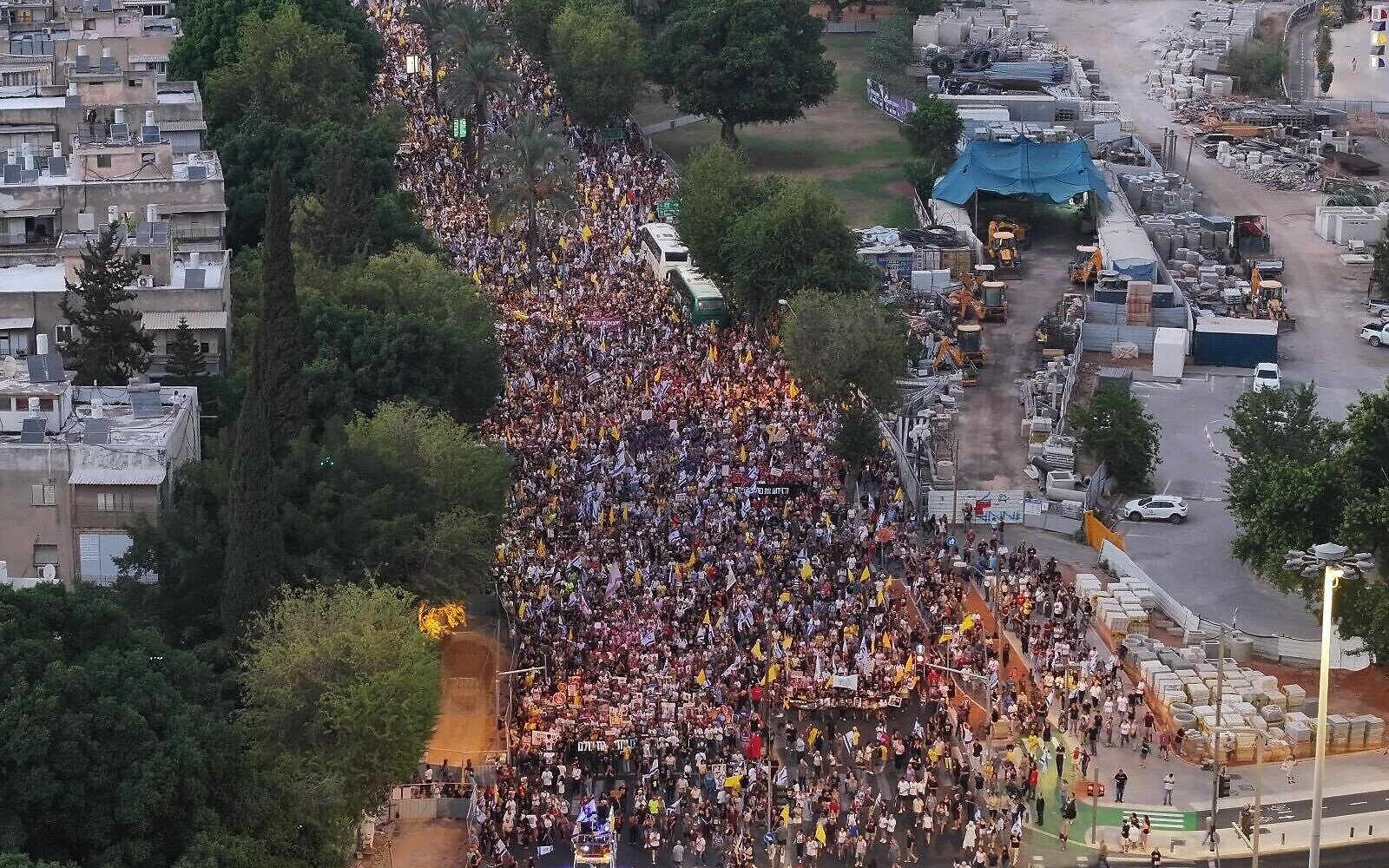
Hundreds of thousands of people took to the streets across the country on Tuesday, as part of an organized day of action demanding the government reach a deal for the release of 50 hostages still held by Hamas and other terrorist organizations in Gaza.
The day’s protests, which saw the blocking of several major highways, marches to the homes of ministers, and protests outside the Prime Minister’s Office as he held a security cabinet meeting there, culminated in a major protest in Tel Aviv’s Hostage Square, which drew some 350,000 people, according to organizers.
The day of action, announced by the Hostages and Missing Families Forum, was the second in two weeks, after a major protest last Sunday drew crowds of over one million, according to the forum, with some 500,000 in Tel Aviv alone.
Throughout the day, protesters blocked highways and major intersections, including Tel Aviv’s Ayalon Highway, Route 1 between Jerusalem and Tel Aviv, the major Route 6 artery, and the Route 2 coastal highway, and in some cases, set fire to tires on the roads.
As Prime Minister Benjamin Netanyahu convened the security cabinet for a meeting at his Jerusalem office, hundreds of protesters marched outside, demanding that the forum agree to the deal that Hamas said it accepted last week.
At the front of the demonstration, members of the socialist Hashomer Hatzair youth movement held a banner that read: “We are one step away from a complete torpedoing,” referring to fears that the government will tank a prospective hostage deal.
The security cabinet meeting concluded without a vote, or even a discussion, on the partial ceasefire proposal, with Netanyahu telling ministers that he will only discuss a comprehensive framework, and that he is moving ahead with the expanded operation to capture Gaza City to pressure Hamas to meet his conditions, according to Hebrew media reports.
In Tel Aviv, protesters marched from the Savidor central train station to Hostages Square, where family members of the hostages addressed the hundreds of thousands of people gathered.
Ofir Braslavski, the father of hostage Rom Braslavski, told the crowd that he “no longer trusts the prime minister” after nearly two years had passed without the return of his son, who he said was “dying.”
“I don’t want to receive my boy in a bag,” Braslavski added.
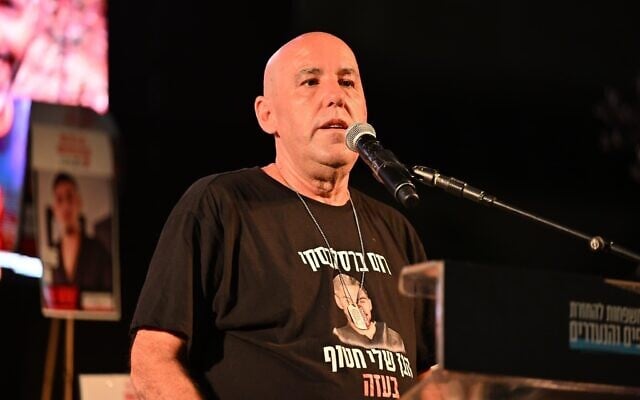
Last month, the Palestinian Islamic Jihad terror group released footage of Rom Braslavski, appearing emaciated and in dire medical condition.
His father called the video reminiscent of “the horrors of the Holocaust, seeing him tortured, suffering.”
But despite the footage, the government “isn’t doing anything,” Braslavski said from the stage. “Two years we are waiting… as if it’s something he [Netanyahu] is doing intentionally.”
“I no longer trust anyone — I don’t trust the prime minister. I don’t trust the government… the only person I trust is the IDF chief of staff [Lt. Gen. Eyal Zamir] he said, referencing the top military official, who on Monday reportedly urged the government to take the hostage deal currently on the table, saying the choice is “in Netanyahu’s hands.”
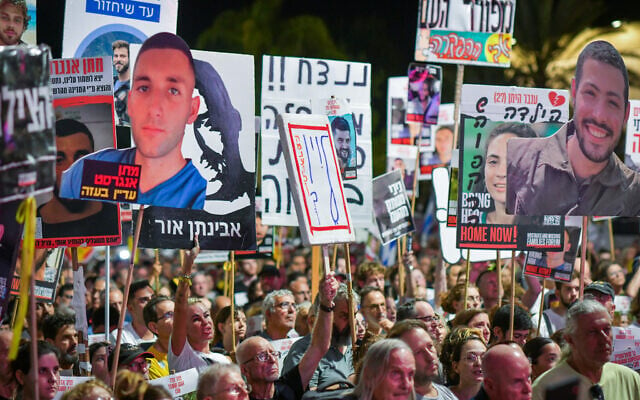
Noam Peri, the daughter of Haim Peri, who was kidnapped by Hamas on October 7 and murdered in captivity, told the crowd: “We don’t want a forever war on the backs of our soldiers and hostages.”
In English, she appealed to US President Donald Trump, urging him to “look at all this crowd… at the pictures from the streets of Israel.”
“The people of Israel are voting with their feet, the nation wants this war to end and the hostages brought home,” she said. “For my father, it is too late, but you can still save the other hostages and be remembered as the president who made history.”
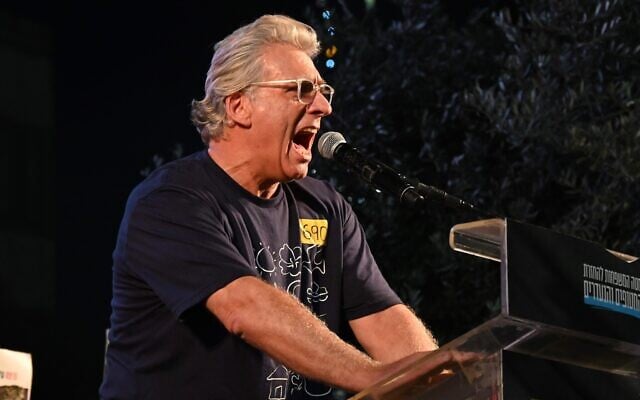
Actor Lior Ashkenazi also delivered a fiery speech lambasting the government, accusing ministers of delaying the signing of a hostage deal.
“An entire week, an entire week, has passed since Hamas sent its agreement,” he says, noting that Netanyahu’s security cabinet met earlier in the day and did not discuss the temporary ceasefire on the table.
“There will be no more routine so long as they [the hostages] are there,” he said, calling on the government to adopt the current proposal for a temporary ceasefire and hostage release.
“Move forward with this agreement, damn it!” he shouted.
“Whoever thought that last week was the peak [of protests], hasn’t seen anything yet,” he said to an eruption of cheers from the crowd.
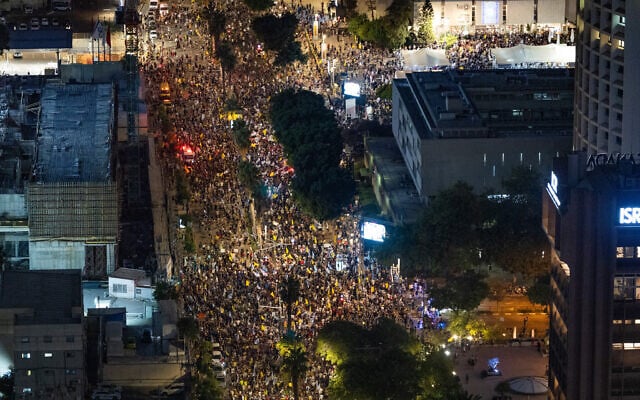
According to a Channel 12 report, following the two days of mass protests, relatives of the captives are now planning to shift tactics and confront politicians directly.
The relatives hope to “disrupt the day” of Netanyahu and cabinet ministers, including by protesting outside their homes on a daily basis, the outlet said, adding that the families also plan to protest government and cabinet meetings, as a group did earlier Tuesday.
Protesters also plan to obstruct the politicians’ movements, the report said, in an effort to constantly remind them of the hostages’ plight.
Terror groups in the Gaza Strip are holding 50 hostages, including 49 of the 251 abducted by Hamas-led terrorists on October 7, 2023. They include the bodies of at least 28 confirmed dead by the IDF. Twenty are believed to be alive, and there are grave concerns for the well-being of two others, Israeli officials have said. Hamas is also holding the body of an IDF soldier killed in Gaza in 2014.
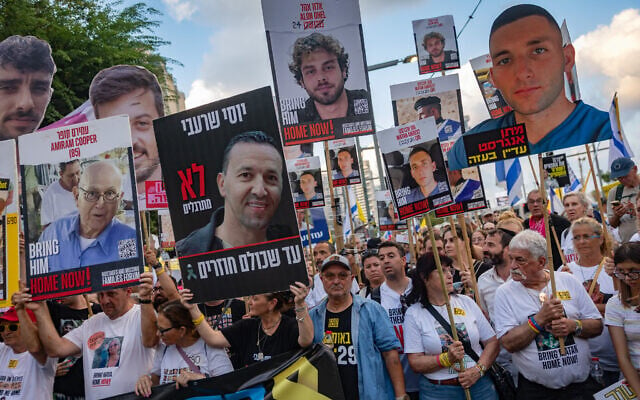
Hamas released 30 hostages — 20 Israeli civilians, five soldiers, and five Thai nationals — and the bodies of eight slain Israeli captives during a ceasefire between January and March, and one additional hostage, a dual American-Israeli citizen, in May as a “gesture” to the United States.
The terror group freed 105 civilians during a weeklong truce in late November 2023, and four hostages were released before that in the early weeks of the war. In exchange, Israel has freed some 2,000 jailed Palestinian terrorists, security prisoners, and Gazan terror suspects detained during the war.
Eight hostages have been rescued from captivity by troops alive, and the bodies of 49 have also been recovered, including three mistakenly killed by the Israeli military as they tried to escape their captors, and the body of a soldier who was killed in 2014.
The Hamas-run Gaza health ministry says more than 62,000 people in the Strip have been killed or are presumed dead in the fighting so far, though the toll cannot be verified and does not differentiate between civilians and fighters. Israel says it has killed over 22,000 combatants in battle as of August and another 1,600 terrorists inside Israel during the October 7 onslaught.
